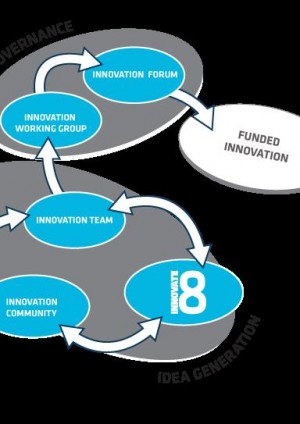
Implementing the Crossrail Innovate18 Programme
Document
type: Micro-report
Author:
Marie Gilmour BEng (Hons), MAPM
Publication
Date: 26/02/2016
-
Abstract
This micro-report explains why the Crossrail Innovation Programme, Innovate18, was established, and how it was implemented. It includes the plan, procedure and document used to manage the process. It will be of interest to sponsors, clients and suppliers working on projects of any size.
-
Read the full document
Inception and developing the strategy
Crossrail’s Chief Executive, Andrew Wolstenholme, recognised the opportunity to develop a systematic innovation programme to harness the creative potential of Crossrail and its supply chains. He commissioned Imperial College to work with members of the Transcend Programme Partner to develop and deliver the Crossrail Innovation strategy. The strategy was developed in the period from June to September 2012, initially focussed on innovating through the construction phase of the project. A pilot was run from October to Dec 2012, at three project sites (Paddington, Liverpool Street and Connaught Tunnel). This focussed on testing methods for engagement and sharing of information. Jan – April 2013 was spent developing terms of reference and operating models, including funding. The programme launched officially in April 2013, with the first round of evaluation ideas in June 2013. The sixth and final full funding round is expected to take place in March 2016.
The Innovate18 programme was unique in the way it was structured and funded, whereby Tier 1 suppliers were invited to join for a £25,000 fee, which was match funded by Crossrail. This provided a pot of money used to seed fund projects, which were evaluated and approved in accordance with programme governance.
Crossrail additionally funded a number of roles for the duration of the project to support coordination, management and delivery of the programme. This comprised the following key activities:
- Engagement with site staff and Innovation Champions to share and publish ideas;
- Providing support to teams to develop implementation plans for innovations;
- Development of business cases and management of a portfolio of investments for funded innovations;
- Delivery of a communication strategy to promote, share and encourage innovation both internally and externally;
- Engagement with the wider innovation community to share good practice.
As the programme evolved, the project team reviewed and revised the strategy, to ensure focus and that innovation strategic themes (Health & Safety, Sustainability, Efficiency and Digital Integration) were aligned with desired project outcomes. This approach saw a change in the nature of innovations being generated, moving from primarily health and safety related through the construction phase, to a trend of digital and efficiency related innovations focussed on supporting M&E fit-out and handover in the later stages of the programme.
A number of legacy documents are available which describe the structures and processes which were applied, as follows:
Innovation Management Plan Describing how Innovation will be resourced and governed. Innovation Management Procedure Describing processes and procedures to be applied in managing investment and delivery. Innovation Management System (IMS) Database used to create a repository of all ideas submitted during the lifetime of the Innovate18 programme, including actions taken with respect to each idea. Innovation Remit Template A template used to define the scope of projects to be invested in, including go/no-go criteria, timescales, resources, budgets and measurement of success. Period Report Example of the monthly reports feeding into the Crossrail period report, describing activities and challenges. The project was named Innovate18 because Crossrail will begin to operate in 2018. Innovate18 will begin to reduce effort in 2016, and from April 2017 onwards, it is not anticipated that there will be a full time Innovation role. In anticipation of this, the team designed a migration strategy which includes the creation of an industry innovation programme. We expect handover of Innovate18 to the new industry programme to take place in 2016.
In this way, the Innovate18 programme has delivered value to the Crossrail project, and through its migration, will continue to provide value to the industry.
Lessons Learned
- At some stages in the programme there has been a lot of focus on whether innovation has provided benefits. However, many of the benefits were difficult to quantify, either because they were soft benefits, such as improvements in behaviours; safety, etc., or because there was no baseline data available against which to compare. Careful thought should be given to objectives and KPIs for an innovation programme to avoid retrospective assessments.
- The programme was very dependent on the enthusiasm and commitment of innovation champions. This worked well where there was top down support from project managers on site, and conversely, delivery was difficult where that support was lacking. Top down support is essential to success, and other innovation enterprises should give thought to how to useexecutive enthusiasm to drive support throughout all levels of the project.
- It is sometimes difficult to justify an innovation programme, and there can be many arguments for and against. A critical aspect of the success of the Innovate18 programme has been top down leadership from Crossrail’s Chief Executive (Andrew Wolstenholme) and the Executive leadership team. Other programmes will need to seek similar leadership and commitment.
- The role of an innovation team is key to the success of an innovation enterprise. Characteristics of the team include enthusiasm, sometimes in the face of cynicism; energy and perseverance to find ways around barriers to change; people skills to constantly maintain levels of enthusiasm and engagement, project management and reporting skills to ensure diligence in managing investments, and focus on transparency and reporting; starter-finishers capable of developing and delivering ideas, and with persuasion skills to gain support from multiple parts of the organisation. The importance of creating the right team needs to be recognised.
- There can be an apparent conflict in public sector projects in achieving an optimum balance between assuring all procurements are in line with government legislation and best practice, and in making it easy to procure and trial new and innovative services and technology. By their definition, frameworks with pre-approved suppliers are not the answer to this. There needs to be further industry discussion around this topic, from two different perspectives:
- Procuring innovation for relatively small investments (anywhere between £1k and £80k) still requires compliance with procurement processes designed for major construction contracts. This therefore is labour intensive, and can seem disproportionate to investments;
- We believe Innovate18 was relatively successful in engaging with SMEs, however we have received consistent feedback from small businesses that the procurement processes in large businesses can be impenetrable. The industry needs to find a way to engage with SMEs in a more agile way.
- In recommending trials for new and innovative products, a barrier can be the lack of a proven history demonstrating robustness or fitness for purpose. A good example is barriers to trialling use of CEMFREE concrete because specifications and standards require use of cement, which by definition makes it impossible to incorporate innovative cement free materials. Similarly, performance based characteristics such as 150 year life are difficult to prove for new products. The industry needs to consider how major projects can collaborate to provide a roadmap for such innovations.
- There is a lot of debate around what constitutes innovation, and various definitions exist. For Innovate18, we focussed on the idea that innovation is the delivery of value from ideas. Value can then be determined in the context of the strategic objectives of the innovating enterprise. For Crossrail, contributing to efficiency, safety and sustainability, and supporting a wealth of research and case studies to be shared with the industry in general, is undoubtedly a valuable contribution!
- We are often asked about how we managed intellectual property issues. By default, we included a caveat on submission of ideas to say that by submitting, innovators were not surrendering intellectual property rights (IPR). This meant that ideas could flow in, and we could assess any issues with IPR at the point when ideas were being developed. In practice, it never presented any issues for us. We either invested in development of open source software, negotiated free use of software, or paid for licences to use products. Any commercialisation of products or activities required to protect IPR remained with innovators if they wanted to proceed down that route. For our programme, we generally found that innovators were mainly interested in improving project outcomes, and not in commercial exploitation of ideas. We feel the lesson learned here is to create a collaborative culture, and deal with issues in a pragmatic way if and when they arise.
Recommendations for Future Projects
We believe that a well executed innovation programme can add tremendous value. We believe that a lot of that value is the collaboration and resultant goodwill generated in projects and the innovation community. There is a correlation between high performing and high innovating contracts on Crossrail, and we believe this is a key to success. The industry could provide guidance on innovation and innovation maturity to ensure innovation practice continues to evolve.
The scope of Innovate18 projects was primarily early stage feasibility and proof of concept. The transition between these small scale technical innovation projects and full scale adoption requires a much longer lead time and more resource. There may be an opportunity on future projects to link innovation activities with change management teams to allow for positive innovation project outputs to be scaled up through formal integration with different teams.
Although the Innovate18 governance process allowed for top level support from various directorates through the Crossrail Innovation Forum, this impact was at times limited as the Crossrail Programme was too far along to introduce independent directorate ownership of innovation activities. If innovation was built into a major infrastructure project from the beginning, and relevant KPIs were developed in collaboration with different directorates, the impact of the innovation programme and the ability to get buy in at all levels would be increased.
-
Authors
Marie Gilmour BEng (Hons), MAPM
Marie Gilmour is a Management Consultant and Innovation Champion with the Nichols Group, engaged as Innovation Programme Manager within Crossrail’s Innovation programme, Innovate18 from Jan 2015 until March 2016.
